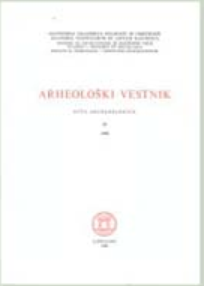Nedavna odkritja na predgrških najdiščih v Mali Aziji
Povzetek
In 1945 knowledge of the pre-hellenic archaeology of Anatolia was uneven. The eastern half of the central plateau was best known, from excavations at Bogazkoy (Hattusas), Alaca Hiiyuk, Alisar Hiiyuk and Kiiltepe (Kaneš). In Cilicia pre-hellenic sites had been investigated at Mersin and Tarsus. Troy was virtually isolated in the north-west. Research in the past fifteen years has had three main objects: to investigate the western regions; to throw light on the prehistory of central Anatolia and the course of the earlier Indo-European migrations into it (between c. 2300 and 1800 B. C .); and to reconstruct the later ethnic movements which destroyed the Anatolian Hittite state c. 1200 B. C. In the central region the most important excavations have been the Turkish at Kiiltepe (near Kayseri) and Karahiiyiik (near Konya) and the third German series at Bogazkoy (near Sun[1]gurlu). At Bogazkoy, the clearing of the citadel area on Biiyukkale continues. It now proves to have been occupied from the end of the 3rd millennium at least. So also was the »lower city«. A colony of Assyrian merchants was settled there in the late 19th or 18th century.1 Recent work at Kiiltepe shows that this site too was occupied from the middle of the Early Bronze Age. The Assyrian »karum« or trading-station there was the earliest and most important of the region. The palace of the contemporary mative rulers has now been investigated, on the main mound. A dagger has been found bearing the name of »Anittas«, a king mentioned in the earliest text from the later Hittite archivesat Bogazkoy.2 The earlier history of Hattusas and Kaneš has still to be correlated with the fuller evidence for general developments in the Early and Middle Bronze Ages obtained from Alaca Hiiyiik, Alisar Hiiyiik, Beycesultan and Karahiiyiik. It is still not clear which destruction levels reflect the immigration of the Indo-European ancestors of the Hittites. Recent work on pre-hellenic western Anatolia, mostly carried out by members of the Bri[1]tish Institute of Archaeology at Ankara, began with any extensive survey of sites, which defined several new pre-hellenic cultural regions. This was followed by excavation of the impressive mound near Beycesultan in the upper Menderes valley.3 The site was inhabited from Late Chalcolithis times, late in the 4th mil[1]lennium at least, to the lith century B. C. Its people developped a high culture re[1]lated to, but distinct from, those of Troy and central Anatolia. The excavators attribute the civilization of its most prosperous period, which they date c. 1900— 1750 B. C., in the Middle Bronze Age, to the Luwians, an Indo-European people related to the Hittites. They consider them to have immigrated c. 2300 B. C. Comparative linguistic evidence, however, does not suggest a gap of several centuries between the immigration of the proto-Luwians and that of the (Indo-European) proto[1]Hittites. The excavators note similarities between the M. B. A. architecture of Beyce[1]sultan and that of Middle Minoan Crete.4 The settlement was impoverished during the periods of greatest Hittite power, and can hardly have been the capital of »Arzawa«. It enjoyed a revival at the end of the 13th century. There is no evidence of important Mycenean influence. Since 1957 J. Mellaart has been excavating a site at Hacilar, near Burdur in southwestern Turkey, which has provided a sequence from Neolithic into Chalcolithic times, connecting with that of the earliest levels at Beycesultan.5 Excavation has still not proved the plausible theory that it was a Phrygian invasion from the north-west that destroyed the Hittite state. The earliest »Phrygian« wall at Bogazkby is reported to lie immediately above the ruins of the latest Hittite buildings. But the period of extensive »Phrygian« settle[1]ment seems to have come later (8th— 6th centuries); and the course of the assumed migration in the 13th and 12th centuries has not been traced.6 The American exca[1]vation at Gordion has not yet reached levels which might give relevant evidence, except in soundings. 8
Prenosi
Prenosi
Objavljeno
Kako citirati
Številka
Rubrike
Licenca

To delo je licencirano pod Creative Commons Priznanje avtorstva-Nekomercialno-Deljenje pod enakimi pogoji 4.0 mednarodno licenco.
Avtorji jamčijo, da je delo njihova avtorska stvaritev, da v njem niso kršene avtorske pravice tretjih oseb ali kake druge pravice. V primeru zahtevkov tretjih oseb se avtorji zavezujejo, da bodo varovali interese založnika ter da bodo povrnili morebitno škodo.
Podrobneje v rubriki: Prispevki





